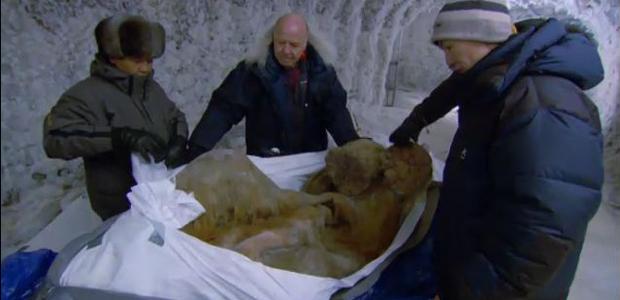Frozen Baby Woolly Mammoth Discovered in Siberia
The mammoth was discovered in Siberia by a team of researchers. (Photo: video grab/BBC)
Marco Werman: Let’s shift now from a creature of today’s ocean to a creature of the past. Scientists recently discovered a baby wooly mammoth preserved in the frozen tundra of northern Siberia. Nicknamed Yuka, the mammoth lived around 10,000 years ago. So you might think there’s not much left to it, but you’d be wrong. It’s amazingly well-preserved. Check out the video at theworld.org. Dan Fisher is a paleo`ntologist, part of a team of researchers who have been studying this wooly mammoth named Yuka. Tell us more about just how well preserved is the body?
Dan Fisher: In terms of the quality of tissue preservation, Yuka is really wonderful. I think almost certainly the best preserved mammoth we have encountered yet. This specimen was less complete than for instance, Lyuba, a baby mammoth that was found in 2007, but Yuka is especially interesting, really very important despite its somewhat incompleteness.
Werman: Describe what the animal would look like.
Fisher: The animal would look much like a baby elephant, maybe a three, we think Yuka was maybe three or so years old at the time its death, four and a half to five feet at the shoulder. It would’ve been of course covered with dense wooly coat.
Werman: And did you find any of that hair on Yuka or maybe trunk?
Fisher: Basically all of Yuka’s skin with the exception of a few small patches is present and in wonderful condition, and the skin is still soft and pliable, and still with much of its original hair, which is a sort of blonde-reddish color.
Werman: Blonde-red hair on a cousin of the elephant, that’s bizarre.
Fisher: Yeah, the hair is especially thick and well-preserved on the animal’s legs and that remain in wonderful condition.
Werman: And tell us where Yuka was discovered specifically.
Fisher: Yuka was found along the coast of the Arctic Ocean, the particularly portion of it called the Laptev Sea, to the east of the delta of the Lena River, one of the major rivers that crosses Siberia from south to north. And the political region known as Yakutia. This was an environment that was inhabited also by wooly rhinos, by musk-ox, by Steppe Bison, by wolves, of course, so this was a vigorous, productive community of organisms that spread across the northern reaches of our world during the Ice Age.
Werman: Dan, earlier you said you found Yuka especially interesting. From a personal point of view what did you find interesting about this newly discovered wooly mammoth?
Fisher: Well, from a personal point of view we’re always eager to study these specimens. There’s many remaining questions that we have about the anatomy and the biology of these animals, and in particular though, Yuka presents some evidence that humans were involved in its history.
Werman: Involved in what way?
Fisher: Involved in the sense that although we have evidence that Yuka was pursued and perhaps killed by we think maybe lions or some large felid predator, we do not in fact see the kinds of damage that lions typically produce as they finish off or finally kill an animal. In fact, what we have instead of this is a strange series of incisions; types of incisions that are not part of the usual let’s say feeding repertoire of lions, or wolves or any of the predators we would expect in this environment, that could have, however, been produced by primitive humans. There are cut marks also on some of the bones of the mammoth that appear to be cut marks made by some sort of sharp implement. It’s too early to say stone tools because we haven’t examined these marks with precision at this point, but that’s certainly on our agenda.
Werman: Sounds like you’ve got another scientific mystery to solve on your hands.
Fisher: We do, that’s the way of life we’ve chosen.
Werman: Dan Fisher, a paleontologist at the Museum of Paleontology at the University of Michigan, thanks very much.
Fisher: You’re welcome.
